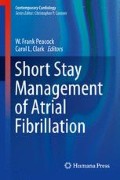Abstract
Discharge planning is the process of evaluating and planning for the patient’s needs post-discharge and begins at the time of admission. All members of the healthcare team as well as the patient and his or her caregiver must contribute to the plan. The discharge plan must be individualized and provide the patient and caregivers with adequate information to sustain them to the next locus of care. Incorporation of the discharge planning process into the routine care and standard order sets will facilitate completion.
Atrial fibrillation (AF), the most common cardiac dysrhythmia seen in the ED, is often first diagnosed in the ED. The prevalence of AF increases with age and is often associated with multiple comorbidities, placing patients with AF in a higher risk category. Patients typically lack an adequate understanding of the disease, symptoms, medication management, stroke risks, and when to seek emergency care. Appropriate discharge plans reduce readmissions, save costs, decrease complications, and improve adherence.
Access this chapter
Tax calculation will be finalised at checkout
Purchases are for personal use only
References
Zavalla S, Shaffer C. Do patients understand discharge instructions? J Emerg Nurs. 2011;37(2):138–40.
Han CY, Barnard A, Chapman H. Discharge planning in the emergency department: a comprehensive approach. J Emerg Nurs. 2009;35(6):525–7.
Agency for Healthcare Research and Quality (AHRQ) IDEAL Discharge.www.ahrq.gov/educatiion/curriculum-tools/susptoolkit/videios/11d_idealdischarte/index.html
Naylor M, et al. Comprehensive discharge planning for the hospitalized elderly-a randomized clinical trial. Ann Intern Med. 1994;120:999–1006.
Kleinpell RM. Randomized trial of an intensive care unit-based early discharge planning intervention for critically ill elderly patient. Am J Crit Care. 2004;13:335–45.
Russo V, et al. Management of atrial fibrillation in the emergency department: current approach and future expectations. Eur Rev Med Pharmacol Sci. 2013;17:3132–47.
McDonald AJ, et al. Increasing US emergency department visit rates and subsequent hospital admissions for atrial fibrillation from 1993 to 2004. Ann Emerg Med. 2008;51(1):58–65.
Patel JN, et al. Contemporary trends for hospitalization for atrial fibrillation in the United States, 2000 through 2010: implication for healthcare planning. Circulation. 2014;129:2371–9.
January CT, Wann LS, Alpert JS, Calkins H, Cigarroa JE, Cleveland Jr JC, Conti JB, Ellinor PT, Ezekowitz MD, Field ME, Murray KT, Sacco RL, Stevenson WG, Tchou PJ, Tracy CM, Yancy CW. 2014 AHA/ACC/HRS guideline for the management of patients with atrial fibrillation: executive summary: a report of the American College of Cardiology/American Heart Association Task Force on Practice Guidelines and the Heart Rhythm Society. J Am Coll Cardio. 2014;64:2246–90.
McMartin K. Discharge planning in chronic conditions: an evidence-based analysis. Ont Health Technol Ass Ser [Internet]. 2013;13(4):1–72. Available from: http://www.hqontario.ca/en/doucments/eds/2013/full-report-OCDM-discharge-planning.pdf.
Besser KV, Mills AM. Is discharge home after emergency department cardioversion safe for the treatment of recent onset atrial fibrillation. Ann Emerg Med. 2011;58(6):517–20.
Decker WW, et al. A prospective, randomized trial of an emergency department observation unit for acute onset atrial fibrillation. Ann Emerg Med. 2008;52(4):322–8.
Mozaffarian D, Benjamin EJ, Go AS, Arnett DK, Blaha MJ, Cushman M, de Ferranti S, Després, J-P, Fullerton HJ, Howard VJ, Huffman MD, Judd SE, Kissela BM, Lackland DT, Lichtman JH, Lisabeth LD, Liu S, Mackey RH, Matchar DB, McGuire DK, Mohler ER 3rd, Moy CS, Muntner P, Mussolino ME, Nasir K, Neumar RW, Nichol G, Palaniappan L, Pandey DK, Reeves MJ, Rodriguez CJ, Sorlie PD, Stein J, Towfighi A, Turan TN, Virani SS, Wiley JZ, Woo D, Yeh RW, Turner MB: on behalf of the American Heart Association Statistics Committee and Stroke Statistics Subcommittee. Heart disease and stroke statistics-2015 update: a report from the American heart Association. Circulation. 2015;131:e1–205.
Camm AJ, et al. Guidelines for the management of atrial fibrillation: The Task Force for the Management of Atrial Fibrillation of the European Society of Cardiology. Eur Heart J. 2010;31:2369–429.
McCabe PJ, et al. Knowledge and self-management behaviors of patients with recently detected atrial fibrillation. Heart Lung. 2008;37(2):79–90.
Eckman MH, et al. Integrating real-time clinical information to provide estimates of net clinical benefit of antithrombotic therapy for patients with atrial fibrillation. Circ Cardiovasc Qual Outcomes. 2014;7:680–6.
Sandy LP. Case management in the emergency room. Prof Case Manag. 2010;15(2):111–3.
Bayliss EA, et al. Descriptions of barriers to self-care by persons with comorbid chronic diseases. Ann Intern Med. 2003;1:15–21. doi:10.1370/afm.4.
Gozdzialski A, Schlutow M, Pittiglio L, Everson F. Patient and family education in the emergency department: How nurses can help. Nurse Educ. 2012;38(3):293–5.
Coleman EA, et al. The care transitions intervention. Arch Intern Med. 2006;166:1822–8.
Samuels-Kalow ME, Stack AM, Porter SC. Effective discharge communication in the emergency department. Ann Emerg Med. 2012;60(2):152–9.
Cleland JG, Ekman I. Enlisting the help of the largest health care workforce: patients. JAMA. 2010;304(12):1383–4.
Engel KG, et al. Communication amidst chaos: challenges to patient communication in the emergency department. JOCM. 2010;17(10):449–52.
Berkman ND, et al. Low health literacy and health outcomes: an updated systematic review. Ann Intern Med. 2011;155:97–107.
McCarthy DM, et al. Emergency department discharge instructions: lessons learned through developing new patient education materials. Emerg Med Int. 2012;2012:306859. http://dx.doi.org/10.1155/2012/306859.
Fuster V, Rydén LE, Asinger RW, Cannom DS, Crijns HJ, Frye RL, Halperin JL, Kay GN, Klein WW, Lévy S, McNamara RL, Prystowsky EN, Wann LS, Wyse DG. ACC/AHA/ESC guidelines for the management of patients with atrial fibrillation: executive summary; a report of the America College of Conferences (committee to develop guidelines for the management of patients with atrial fibrillation). Circulation. 2001;104:2118–50.
Jack BW, et al. A reengineered hospital discharge program to decrease rehospitalization. Ann Intern Med. 2009;150(3):178–87.
Kee CC, Borchers L. Reducing readmission rates through discharge interventions. Clin Nurs Spec. 1998;12:206–9.
Anthony MK, Hudson-Barr D. A patient-centered model of care for hospital discharge. Clin Nurs Res. 2004;13:117–36.
Author information
Authors and Affiliations
Corresponding authors
Editor information
Editors and Affiliations
Rights and permissions
Copyright information
© 2016 Springer International Publishing Switzerland
About this chapter
Cite this chapter
Conway, G., Bell, B. (2016). Discharge Planning. In: Peacock, W., Clark, C. (eds) Short Stay Management of Atrial Fibrillation. Contemporary Cardiology. Humana Press, Cham. https://doi.org/10.1007/978-3-319-31386-3_17
Download citation
DOI: https://doi.org/10.1007/978-3-319-31386-3_17
Published:
Publisher Name: Humana Press, Cham
Print ISBN: 978-3-319-31384-9
Online ISBN: 978-3-319-31386-3
eBook Packages: MedicineMedicine (R0)

